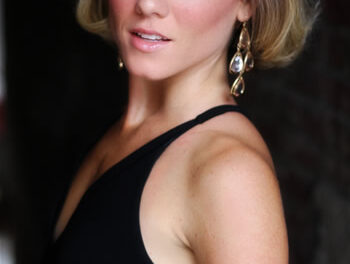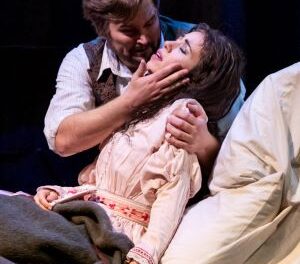As the Eastern Music Festival‘s second week opened, it was already clear that this summer will prove to be another triumph. While the faculty performances I have been lucky enough to hear have been superb, the special guest artists in the Pacifica Quartet presented an absolutely glorious afternoon of music. The quartet is made up of Simin Ganatra and Austin Hartman, violins, Mark Holloway, viola, and Brandon Vamos, cello – all accomplished and award-winning solo performers in their own right – but when combined, they become something cohesive and magical. (Pacifica performers’ bios may be read here.)
Currently serving as resident quartet of Indiana University’s Jacobs School of Music, the Pacifica Quartet is young and ambitious, having recently dedicated their time to performing the complete string quartet cycles of Carter, Mendelssohn, Shostakovich, and Beethoven – sometimes in just three days per cycle! What a treat it was, indeed, to have the opportunity to hear the masters perform from three of these monumental bodies of work.
The concert began with Mendelssohn’s Quartet No. 3 in D, Op. 44, No. 1 (1838), in bright and joyful melody. The roles of the players shifted deftly, from traditional structure of violins in melody and the lower strings in accompaniment, to cello and viola solo moments, and back again from one phrase to the next. The balance was impeccable when Ganatra’s delicate melodies soared over the rest, but also when they all completed a phrase as equal players. Their exuberance was engaging in its high, powerful strains, but also delicate and poignant at softer moments. In the second movement, the Menuetto, Ganatra led the others through sensitive, lingering placements of especially complex chords, holding out for just an extra moment before hitting resolutions made sweeter by their delayed release. The fourth and last movement of the work, the driving Presto con brio, began to hint at the ensemble’s stamina; forty minutes into the concert, as the energy and exertion ramped up considerably, the players seemed to grow more energized from the very velocity at which they played, constantly refueling and building up energy for passionate, heavy bow strokes – and alternately diminishing for silky touches of the strings in the very next moment, until the piece worked its way to a bouncing, enthusiastic close.
After a pause came a work from the other end of the quartet spectrum, the 1944 Shostakovich Quartet No. 2 in A, Op. 68. From an outsider’s perspective, this work would not appear to live comfortably in A major for long; the overall mood is haunting and unsettling, full of complex, contemporary 20th century chords. The first movement, the Overture (Moderato con moto) was nothing short of striking, showcasing a wide tonal range, the dramatic, vocal timbre of Holloway’s solo viola, and eventually unbridled harmonic dissonance.
The Recitative and Romance (Adagio) second movement began with a wandering, exploratory solo line played by Ganatra sumptuously and passionately – without straying into overt indulgence of herself. The accompaniment was ethereal and smooth, moving seamlessly through unmeasured chords as if they were one voice. The plaintive voice of Vamos’ cello picked up the solo, transitioning into the Romance section and slipping deftly into a lush, singing sound.
The third movement, a dark and haunting Waltz (Allegro) that conjures images of softly dancing ghosts in a dim graveyard, moved from the same full cello sound into quick, agitated group motion, realized with great precision before falling back into a shadowy softness. This was another moment in which Vamos’ sound shone: a glorious, ethereal wail of passion. Finally, the Theme and Variations final movement (Adagio) began with a slow, somber theme, gradually sweetened by a lighter sound from Ganatra and Hartman. After their entrance, the work picked up in velocity and excitement, lending the dancelike variations a growing ferocity even as the technical demand on the players grew to the end.
The second half of this mammoth program was Beethoven’s Quartet No. 9 in C, Op. 59, the third of the “Razumovsky” quartets, dedicated to a count by this name in 1806. Although the oldest of the three works, it was the most extraordinary – just as it was in its time, only now more appreciated for the complex work that it is. Upon its reception, the story goes, members of the court actually laughed at how strange and difficult it was. The Pacifica Quartet seemed to particularly enjoy this work; I moved from the balcony to a closer seat during intermission, and was able to see more clearly the expressions on the players’ faces. Their movements may have been overly theatrical – Hartman even left his chair during one particularly exciting passage – but their bodies and faces reflected an exuberant energy that evolved with each phrase.
The abrupt launch from melancholy opening chords into the first melody in a major key was a refreshing respite after the unsettling Shostakovich. The group launched through sinewy running lines, punctuated strong accents in group moments, and culminated into a charming whole. The second movement was absolutely exquisite, characterized by strong, incessant pizzicato by Vamos, and voluptuous melodies throughout. Returning to a refined, Classical sound, the third movement exemplified the group’s cohesion with quick runs moving from person to person, up and down the range of the instruments. Its cheerful and pleasant nature segued right into a ferocious viola line to begin the final movement. The dramatically changing chords and unification of fragmented melodies between parts again seemed to re-energize the players, who charged on unabashed and with even more joy in their faces than before.
While the concert was quite long for a chamber ensemble – clocking in at just over two and a half hours – it neither felt tedious nor seemed to take a toll on the players’ stamina. This action movie of a program was lively, varied, and always in earnest. It’s easy to see why this “signature performance” was so vastly attended, and why EMF is such a treasure. Thanks to Pacifica for making the trek South and sharing their brilliance with our community.
The Eastern Music Festival continues through July 27. See our calendar for more information.
Editor’s Note: It’s been 15 years since the Pacifica debuted in NC in a Raleigh concert during a fierce storm, Since then this ensemble has become one of the world’s leading quartets, as the audiences in Greensboro for this concert and its appearance with orchestra the day before clearly sensed.












